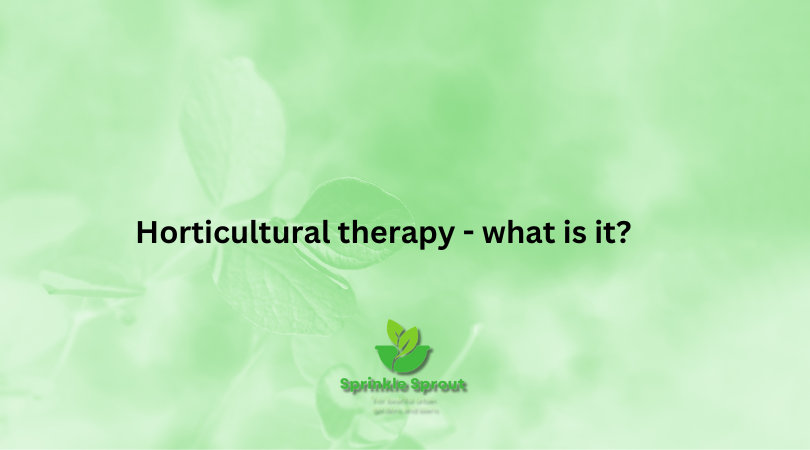Horticultural therapy is a therapeutic practice that uses gardening and plant-related activities to support healing and rehabilitation. Facilitated by trained professionals known as horticultural therapists, this approach helps individuals achieve specific mental, physical, and emotional goals. Through carefully designed activities like planting, watering, and caring for plants, horticultural therapy can benefit a wide range of people, including those with physical disabilities, mental health challenges, and cognitive impairments.
Key Components of Horticultural Therapy
Horticultural therapy is structured around several core components to ensure positive outcomes for participants:
1. Therapeutic Goals
Horticultural therapy focuses on specific objectives related to improving psychological, physical, cognitive, social, and vocational well-being. Participants engage in activities like planting seeds, watering plants, and maintaining gardens, which can enhance motor skills, cognitive function, and emotional resilience. These tasks are tailored to meet individual needs, providing a unique, goal-driven experience for each participant .
2. Variety of Settings
This therapy can take place in diverse environments, each of which adapts horticultural activities to meet the unique needs of participants. Common settings include:
- Hospitals and rehabilitation centers
- Schools
- Community gardens
- Correctional facilities
Each location modifies its program to fit the therapeutic and personal development needs of its participants .
3. Different Types of Horticultural Therapy Programs
Horticultural therapy programs are often divided into three main categories:
- Vocational Horticultural Therapy: Focuses on teaching practical gardening and plant care skills that participants can use in the workplace.
- Therapeutic Horticultural Therapy: Designed to support medical recovery, this approach promotes overall health and well-being through hands-on nature interaction.
- Social Horticultural Therapy: Primarily recreational, this type emphasizes leisure and social interaction without defined therapeutic goals .
Historical Background of Horticultural Therapy
The practice of horticultural therapy dates back to ancient times, but it gained formal recognition in the 19th century. Dr. Benjamin Rush, one of the founding fathers of American psychiatry, was among the first to document its benefits for mental health. Since then, horticultural therapy has evolved, expanding its applications to include physical rehabilitation, vocational training, and social development .
The Benefits of Horticultural Therapy
Research indicates that horticultural therapy offers a wide range of benefits across mental, physical, and emotional health domains:
1. Mental Health Benefits
Gardening and interacting with plants can reduce symptoms of anxiety, depression, and stress. The calming nature of gardening activities helps participants feel more connected to the present moment, reducing negative emotions and promoting relaxation. Research has found that nature-based therapy, such as horticultural therapy, significantly improves mood and overall mental health .
2. Physical Rehabilitation
Horticultural therapy is also effective in physical rehabilitation. Gardening tasks require movement, which can help improve strength, coordination, balance, and endurance. Simple tasks like digging, planting, and pruning can enhance fine and gross motor skills, particularly in individuals recovering from physical injuries or surgeries. Over time, these activities can boost mobility and improve overall physical health .
3. Social Interaction and Community Building
Group gardening activities in horticultural therapy create opportunities for social interaction and community building. Participants often work together to care for gardens, fostering teamwork and collaboration. These shared experiences can help individuals improve their communication skills, build relationships, and develop a sense of belonging. In social horticultural therapy, the emphasis on leisure and interaction helps create a supportive, inclusive environment .
4. Cognitive Benefits
Horticultural therapy also has significant cognitive benefits. Structured gardening tasks can improve memory, attention span, and problem-solving skills. These cognitive exercises are particularly helpful for individuals with dementia, Alzheimer’s disease, or other cognitive impairments, as they help maintain and stimulate mental function through regular interaction with nature .
Horticultural Therapy as a Path to Healing
Horticultural therapy offers a holistic approach to healing, benefiting individuals with a variety of physical, mental, and emotional challenges. Whether through enhancing motor skills, improving mental health, or fostering social connections, gardening provides a therapeutic outlet that promotes overall well-being. By engaging with nature in a structured way, participants in horticultural therapy experience the profound healing power of plants, making it an effective treatment in various settings, from hospitals to community gardens.
